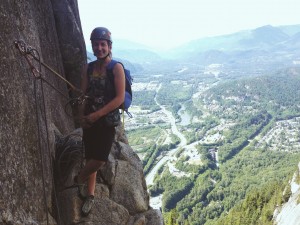Class this week caused me to reflect on my own experiences with gymnastics and how much I loved it. It was always my favourite unit of PE throughout elementary school. It was always an exciting time walking into the gym and noticing the gymnastics equipment set up. I think the main reason I liked it is because it really felt like simple play. In my experience, gymnastics never had a distinct set of rules to follow, unlike other units such as basketball or volleyball. Of course we had to stay safe, but we were also able to explore new movements and positions our own way. We usually worked through stations and tried different moves. We were also given the opportunity to create our own gymnastics routine. I remember this being a highlight in Grade 3.
I think opportunities for kids to create their own routine or game is very important. My practicum class created their own game and the kids were very engaged. For the Pro D Day I attended a “5 steps to a happy classroom” workshop with Scott Hughes and he discussed the importance of play in the classroom. Creative play is an opportunity for kids to engage in their own learning and feel a sense of ownership over what they are doing. I think this can be applied to gymnastics and many other subjects. It allows students to be creative and to contribute to their own learning environment. I hope to bring many experiences like this to my future classroom!
I enjoyed talking about different approaches to teaching PE this week. I had never heard of TGFU until our discussion. I really like the idea of teaching a game through another game, and slowly working out the details and the technique later on. I think TGFU makes a lot of sense because it’s hands on, it gets kids moving right away and it gives each learner the opportunity to participate even if they do not have the technique perfect. I also like this approach because I think it encourages more lifelong learning for students because it is fun, as opposed to putting stress on the rules of a game at the beginning.
I think this approach also applies to theories we have been learning in other classes. For example, in Lisa’s class we discussed the Whole Part Whole approach. I think it’s a similar concept – introduce the large idea first, investigate each part, and reconvene to apply the finer details to the whole lesson again.
I look forward to using this technique in my future classes!
I really enjoyed today’s discussion on physical literacy. I think being fit can mean so many more things than just being good at the traditional sports we see in a gymnasium. For example, in my own experience rock climbing I have been able to develop a love for a sport that has been more of a lifestyle for me than just a means to work out. Rock climbing makes me feel extremely vulnerable and forces me to think about each move I make. This idea helps me feel like I’ve truly accomplished something when I complete a route. Not only does it allow me to work on strength, but it encourages me to get outside in new and beautiful places. Communication is also hugely important, and you must trust your climbing partner with every move you make. These are all physical and mental skills that can be applied to every day life and in the classroom as well.
What’s interesting is that even though I consider myself “physically literate” in rock climbing – I have horrible arm strength! In fact, I can’t even perform a pull up. Maybe I could achieve one or two with horrible form, but if I was tested on this in a gym I would likely fail. Yet I can successfully tie knots, and use technique and balance to rock climb all the way up the Chief in Squamish. I think this shows a great deal about how our definition of fitness needs to change.

When I reflect on my own experiences in physical education as a kid I have mostly positive memories. I was never a star athlete, but I was fortunate to not have any traumatic experiences. I feel that my teachers did a good job in creating an inclusive and positive environment. But when I think about what sort of PE teacher I would like to be, I think about what sort of values and lessons I would like to teach my students. I’ve realized I am less concerned about teaching them about physical fitness, and more concerned about teaching them about what it means to lead a healthy life – or perhaps helping them define what “health” means to them. I think being a good athlete is only one small aspect of what it means to lead an active or healthy life.
I grew up as a competitive synchronized swimmer and spent plenty of mornings dreading the fact I had to jump into a cold pool and swim a thousand meters. Overall, I think this training taught me more social and emotional lessons than physical. It taught me how to work in a team. It also taught me how to “suck it up” and deal with moments that I wanted to avoid or skip out on. I hope that I can help debunk the myth that gym class is only about physical fitness. I believe the more we, as educators, enforce that health is about the number of lengths you can swim or weight you can lift, the further we will be from nurturing a generation that is physically, emotionally and socially “healthy”.
UBC Health Outdoor and Physical Education

